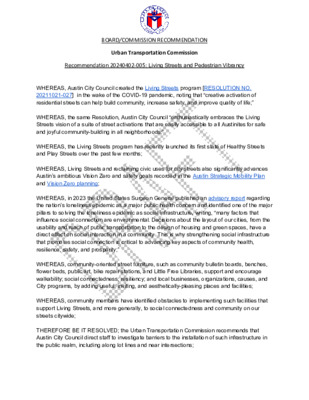05 Living Streets and Pedestrian Vibrancy Recommendation — original pdf
Backup

BOARD/COMMISSION RECOMMENDATION Urban Transportation Commission Recommendation 20240402‐005: Living Streets and Pedestrian Vibrancy WHEREAS, Austin City Council created the Living Streets program [RESOLUTION NO. 20211021-027] in the wake of the COVID-19 pandemic, noting that “creative activation of residential streets can help build community, increase safety, and improve quality of life;” WHEREAS, the same Resolution, Austin City Council “enthusiastically embraces the Living Streets vision of a suite of street activations that are easily accessible to all Austinites for safe and joyful community-building in all neighborhoods;” WHEREAS, the Living Streets program has recently launched its first slate of Healthy Streets and Play Streets over the past few months; WHEREAS, Living Streets and reclaiming civic uses for city streets also significantly advances Austin’s ambitious Vision Zero and safety goals recorded in the Austin Strategic Mobility Plan and Vision Zero planning; WHEREAS, in 2023 the United States Surgeon General published an advisory report regarding the nation’s loneliness epidemic as a major public health concern and identified one of the major pillars to solving the loneliness epidemic as social infrastructure, writing, “many factors that influence social connection are environmental. Decisions about the layout of our cities, from the usability and reach of public transportation to the design of housing and green spaces, have a direct effect on social interaction in a community. This is why strengthening social infrastructure that promotes social connection is critical to advancing key aspects of community health, resilience, safety, and prosperity;” WHEREAS, community-oriented street furniture, such as community bulletin boards, benches, flower beds, public art, bike repair stations, and Little Free Libraries, support and encourage walkability; social connectedness; resiliency; and local businesses, organizations, causes, and City programs, by adding useful, inviting, and aesthetically-pleasing places and facilities; WHEREAS, community members have identified obstacles to implementing such facilities that support Living Streets, and more generally, to social connectedness and community on our streets citywide; THEREFORE BE IT RESOLVED; the Urban Transportation Commission recommends that Austin City Council direct staff to investigate barriers to the installation of such infrastructure in the public realm, including along lot lines and near intersections; BE IT FURTHER RESOLVED, the Urban Transportation Commission urges Austin City Council and Austin Transportation and Public Works to propose and pass code amendments to remove barriers to community-oriented street furniture in the public realm and allow residents to freely install social infrastructure; BE IT FURTHER RESOLVED, the Urban Transportation Commission recommends that Austin City Council and Austin Transportation and Public Works Department consider City programs to encourage community-oriented street furniture, including the City potentially designing and installing social infrastructure; BE IT FURTHER RESOLVED, the Urban Transportation Commission recommends that Austin City Council and Austin and Transportation and Public Works continue their efforts to coordinate so that successful and popular Living Streets projects are eventually transitioned to Shared Streets with more permanent and attractive street treatments; BE IT FURTHER RESOLVED, that the Urban Transportation Commission recommends that Austin City Council initiate code amendments to remove the permitting requirement for Neighborhood Block Parties and move the application from the Austin, Build + Connect permitting portal to the Smart Mobility Portal that maintains the applications for Healthy and Play Streets;